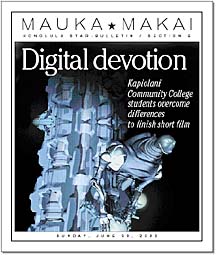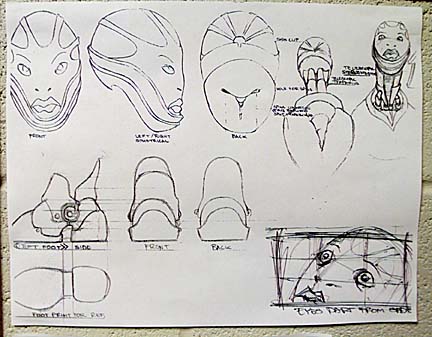


[ MAUKA-MAKAI ]
3-D digital AMID ALL THE fuss over a new film school being planned for the University of Hawaii-Manoa, a small group of students from Kapiolani Community College's New Media Arts Program have quietly spent the last three semesters producing a three-dimensional animated movie titled "N'Philim." The 10 aspiring filmmakers were responsible for all aspects of the ambitious project, from conception to final production. By all accounts, the process of making the minutes-long "N'Philim, featuring a cyborg on the run, " wasn't easy.
doggedness
KCC students devote semesters
of passion and pain to produce
a complex computer-animated filmBy Jason Genegabus
jgenegabus@starbulletin.com
"Not knowing how to do (animation) in the first place forces you to take it upon yourself to solve it," said project member Dean Galura of the lofty goals set for the short film by the class. "All of us were newbies, and the only thing that got us going was a willingness to work hard and our interest in this as a career," he said.
Click to view clip (2.9 MB)
Requires Quicktime viewer
Click here to get Quicktime
GUIDING THE STUDENTS over the past year was instructor Ursula Garcia, who joined the faculty at KCC after eight years of working as an artist and senior producer in the 3-D industry. Garcia came to KCC from Spain at the start of the fall 2000 semester, and was later selected to oversee the "N'Philim" project when a grant funded by the Pacific Center for Advanced Technology Training was used to purchase computers configured for computer animation.
"We were lucky to have excellent equipment," said Garcia of the 10 computers acquired last summer. "Our goal for the first year of operation was to design a production-specific curriculum that provided our students with the best computer graphics training possible.
"In order to focus the training of the students and their understanding of all the phases involved in computer graphics production from a professional point of view, the New Media Arts production center simulates a real computer graphics studio," Garcia said.
COURTESY IMAGE
A cyborg's on the loose in the animated film "N'Philim."
With the help of KCC information technology manager Bo Kwock, work stations were set up, and students began to brainstorm story lines for the project. Students received class credit for their part in producing the short film, though Garcia stressed that "the experience begun in summer 2001 cannot be considered a class in the way it traditionally operates.
"The execution and successful completion of the 3-D animation short film being developed is the primary objective of the students involved in the project, and the process itself is used as the main learning tool," Garcia explained.
FOR THE FIRST few weeks last summer, project members went back and forth with different ideas for the film. "The (first) six weeks was brainstorming the story," said Galura. "We kept coming in each day and presenting stuff at our meetings. Most of everybody's backgrounds were general art, so Ursula's background really brought this all together."
DENNIS ODA / DODA@STARBULLETIN.COM
From left, Ryan Lang, Benedict Apuna, Chris Won and Dean Galura display the storyboards for an animated short film, "N'Philim." The Kapiolani Community College new media arts students spent three semesters developing the movie from concept to completion.
"If you can believe it, this started out as an anti-drug kind of thing," said Ryan Lang. That preliminary story line, developed while the New Media Arts Program applied for funding last summer, was quickly shot down by the rest of the class, however. According to Lang and other students who worked on the project, it was this initial disagreement that started them on the path to further problems.
Lang described class sessions last summer when story ideas were being fleshed out as almost like "The Jerry Springer Show" at times. A clash of personalities and creative differences meant a lot of tension in the New Media Arts lab and hurt feelings among the students. According to Benedict Apuna, "when you have a group of people and some just drag their feet, other people get angry. I was trying to get people to come together, (but) in the end I had to give up."
Apuna wasn't the only one unhappy with the situation last summer. Project member Chris Won also admitted that "morale was pretty low. For a while I didn't want to come in."
Other students didn't just think about jumping ship, they went ahead and took action.
"I just stopped coming in," said Lang with a laugh when he heard of Won's unhappiness. "I didn't want any part of that. Sometimes ideas would just get shut down. It seemed like there was no room for other people's input," he said.
The group kept trying, however, and eventually was able to develop what became the film's current story line. "There was a long evolution. We sort of picked from everyone's concepts, and it sort of meshed together," said Won.
ONCE project members were able to agree on a story line for "N'Philim," the next step was the actual process of developing the animation. Most of the project members had already taken classes on Maya, a software program developed by the company Alias|Wavefront. The software is the main tool used to perform the modeling and rendering needed to produce a 3-D animated film. Other software used for the movie included Adobe Premiere and Adobe After Effects.
Students then split into two groups, each working on a separate scene that would be combined to produce the final product. Galura explained that "the script has two areas of focus, the 'desert' scene and the 'lab' scene.
"When we came back from summer break, we broke into research and development for about a month. It was film analysis, and we never had any understanding of film or shot breakdowns. We started to research how to construct storyboards" for the film, he said. While each scene focused on the main character, a female cyborg, the two groups produced separate action sequences that built upon what they had learned.
DENNIS ODA / DODA@STARBULLETIN.COM
Students in Kapiolani Community College's New Media Arts Program used concept drawings, above and below, to develop characters before using computer software to digitize the art. The drawings were one of the first steps in producing "N'Philim."

Around this time, the class also had to deal with turnover among the students. With all the drama involved, a pair of team members decided not to participate when the class regrouped last fall. That wasn't necessarily a bad thing, according to Won. New additions to the class in fall 2001 and again in spring 2002 "helped us better the project," he said.
"They'd never seen it, and we'd never shown it to anybody else," said Won of the unfinished movie when new students would join the team. "Showing it to them and getting their honest opinions was really good."
Even with all the discord, the students were proud of the fact they were able to work through their disagreements. "I really learned what it is to be committed to something," Won said. "It was a good experience, especially toward the end of this project -- having to meet our big deadlines." Working on "N'Philim" helped to teach Won "really good team skills ... how to work in a group, to depend and rely on other people."
Apuna agreed. "Working through our problems was a big part of the class," he said. Lang also thought that having Garcia as an instructor helped them progress as a group. "Sometimes it felt like she was expecting so much from us," said Lang.
"But she was pushing us because she wanted us to be that much better. After you calm down, you realize it's all for the best," he said.
WHEN "N'PHILIM" premiered earlier this month at KCC, it was only with the help of a last-minute push to finish the movie by a handful of students. According to Galura, "there were five of us who kept coming in" even though the spring semester had already finished.
COURTESY IMAGE
A female cyborg is the main character of "N'Philim."
"We were still modeling and trying to do the editing," he said. "Ursula was taking her own time to be there; she pretty much kept us going. If she didn't stay at the end of May, I don't think we would have finished it the way we did," Galura said.
During the final months of work on "N'Philim," project members also found themselves turning to the Internet for advice from other animators from around the country, a resource that hadn't been available to filmmakers until about five years ago.
"A lot of the information we couldn't get in class," acknowledged Galura. "Primarily we started searching the web. We found a lot of information from professionals that way.
"We'd post up questions, and we'd always see something that pertains to us because they were doing the same things," he said. "We were educating ourselves as to what they were going through."
NOW THAT THE film is complete, a group of students who worked on "N'Philim" plan to represent KCC next month at Siggraph 2002. The conference, which explores "leading-edge theory and practice of computer graphics and interactive techniques," according to the organization's Web site, expects more than 20,000 attendees from 75 countries around the world. "N'Philim" will also be on exhibit at the conference, scheduled for July 21 to 26 in San Antonio.
"It's awesome," said Galura of the Siggraph experience. "I went last year. I've always thought of conventions as something I could just read about after, but being there ... it's overwhelming.
"It's like an international airport; you have all these people and different languages," he said. There are also plans to enter "N'Philim" in the 'Ohina Short Film Showcase later this summer and possibly screen the film again on campus at KCC this fall.
ALTHOUGH Garcia left KCC at the end of this spring semester, she thinks her departure won't affect the future of this unique class offering. "I think that with 'N'Philim' we've demonstrated that our students can be prepared to achieve results at the level of the good 3-D animation schools in the mainland," she said. "At KCC we are lucky to have excellent equipment and a good program."
Click for online
calendars and events.